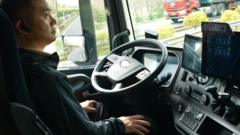Driverless trucks are making waves on Chinese highways, promising increased efficiency and reduced costs, but challenges such as public skepticism and safety concerns remain.
China's Autonomous Trucks: Navigating the Future of Transportation

China's Autonomous Trucks: Navigating the Future of Transportation
A glimpse into China's burgeoning driverless truck industry and its implications for the transport sector.
The autonomous transport revolution is rolling down the highways of China, where driverless trucks are making their presence felt, particularly along the route between Beijing and the Tianjin port. These massive, self-navigating lorries are set to change the landscape of logistics and transportation in the country. Although a safety driver is present to comply with regulations, many experts predict that human oversight will soon become unnecessary as the technology matures.
Safety driver Huo Kangtian, 32, relayed his mixed feelings about relinquishing control of the powerful machine. Initially apprehensive, Huo now feels confident following extensive observation and testing. “I actually think they are pretty good and safe,” he remarked as he interacts with the vehicle's autonomous features. He outlined his responsibility as a safety driver as a last line of defense in emergencies, although he believes the system reduces stress and fatigue associated with long-haul driving.
Pony AI, a leading autonomous vehicle company, underscores the growing efficiency that will come from a fully automated freight industry. Vice president Li Hengyu emphasized that automation promises financial savings, reduced labor costs, and better handling of challenging driving conditions. Yang Ruigang, a technology expert, suggested that the ultimate objective is to drastically minimize driver costs, potentially bringing them close to zero.
Despite the optimism in the industry, hurdles remain before self-driving vehicles are fully integrated into public roads worldwide. Public perception forms a crucial barrier, particularly after a tragic accident involving a self-driving vehicle in China, which claimed the lives of three students. Analysts suggest that a cultural shift must occur before the widespread acceptance of autonomous trucks can be realized.
In Hefei, a city in Eastern China, driverless delivery vans reflect a successful implementation of autonomous technology. Gary Huang from Rino.ai highlighted how these vehicles streamline logistics, allowing human workers to focus on local deliveries while automated systems handle longer distances. With over 500 vans already operating across 50 cities, Huang noted the swift adaptation of such technology during a time of government support and experimentation.
However, industry experts like Professor Yang contend that full autonomy for heavy trucks on highways remains at least five years away. They express optimism, indicating that the most feasible applications may involve driving in hostile environments or on roads devoid of heavy traffic.
Nevertheless, technical limitations persist. Heavy trucks demand advanced sensors for effective hazard detection and road navigation, and integrating these features into older truck models complicates progress. The industry must balance innovation with public safety, as public tolerance for errors in autonomous systems is much lower than for human drivers.
In conclusion, while China's movement towards driverless trucks shows immense potential for transforming the transportation sector, it faces significant challenges ahead regarding safety and public acceptance. The key to success will lie in the reliable performance of these autonomous systems and the gradual shift in public perception towards their benefits.



















